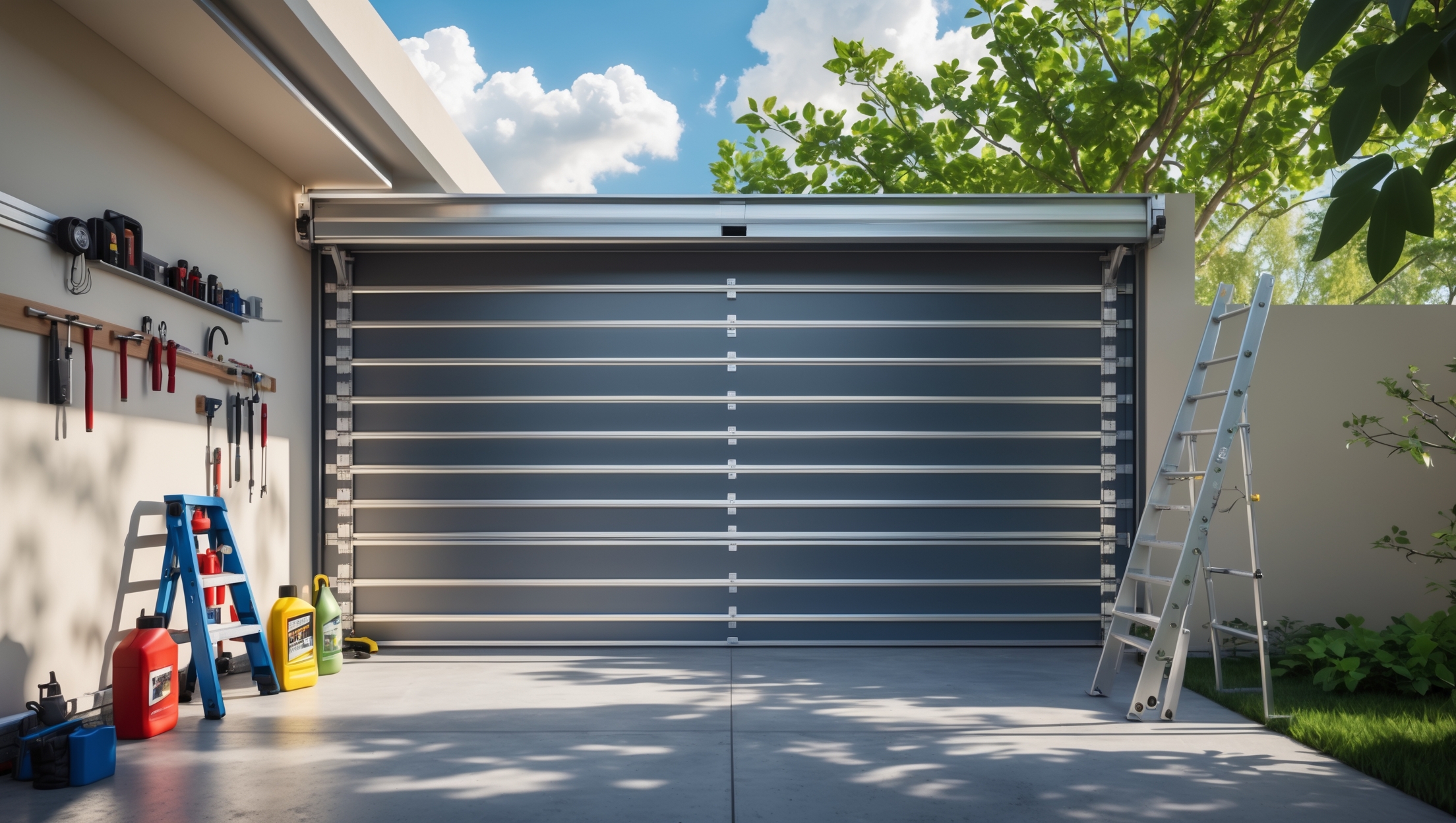Introduction: Why Garage Door Maintenance Matters
When it comes to home improvement, the garage door is often overlooked—until it refuses to open on a cold morning or starts making unsettling noises. Yet, as one of the largest moving parts in your home, the garage door is central to daily convenience, curb appeal, and even security. Proactive maintenance doesn’t just extend the door’s lifespan; it helps prevent costly emergency repairs, ensures smooth and quiet operation, and maintains safety for everyone in your household. Whether your garage is a workshop, storage area, or primary entry point, keeping the door in top condition is a smart investment. In this comprehensive guide, we’ll break down the essential tools and supplies, provide a detailed cost analysis, and walk you through seasonal best practices. By the end, you’ll have a clear, actionable plan to keep your garage door running reliably year-round.
Understanding Your Garage Door System
Main Components
- Panels: The sections making up the door’s face, often made of steel, wood, or composite materials.
- Tracks: Metal rails guiding the door’s movement up and down.
- Rollers: Small wheels that travel inside the tracks, enabling smooth operation.
- Springs: Torsion or extension springs counterbalance the door’s weight.
- Hinges: Connect panels and allow the door to bend as it opens.
- Weatherstripping: Seals gaps, keeping out drafts, pests, and moisture.
- Opener: The motorized device controlling the door, often with remotes and safety sensors.
Understanding these parts is key to effective maintenance and troubleshooting common issues.
Essential Tools and Supplies
Basic Tools for DIY Maintenance
- Socket and wrench set: For tightening bolts and hardware.
- Screwdrivers: Both Phillips and flathead for adjusting screws and opener covers.
- Pliers and locking vice grips: Useful for securing components during adjustment.
- Ladder: A sturdy step ladder (at least 6 feet) for safe access to overhead parts.
- Level: To check track alignment and door balance.
- Work gloves and safety glasses: For protection from sharp edges and debris.
Maintenance Products
- Garage door lubricant: Lithium-based spray or silicone lubricant, specifically formulated for door hardware.
- All-purpose cleaner: Mild detergent for cleaning panels and tracks.
- Rags and soft brushes: For removing dust and grime.
- Replacement weatherstripping: Available in kits for bottom and side seals.
- Batteries: For remotes and backup power units.
Cost Breakdown: What to Budget For
DIY Maintenance Costs
- Lubricant: $7–$12 per can (lasts 1–2 seasons)
- Weatherstripping: $15–$40 depending on door size and material
- Basic tools: $40–$75 (one-time investment)
- Batteries: $5–$15 per pack
Annual DIY maintenance typically costs $30–$60, assuming you already own the basic tools. Investing in quality lubricants and replacement parts can save hundreds in future repairs.
Professional Service Costs
- Annual tune-up: $80–$150 (includes inspection, lubrication, minor adjustments)
- Spring replacement: $120–$350 (parts and labor)
- Opener repair: $100–$250
Regular DIY maintenance can help you avoid or delay these more expensive service calls.
Seasonal Garage Door Maintenance Checklist
Spring: Preparing for Humidity and Pollen
- Clean tracks and rollers: Use a soft brush and mild detergent to remove dust and pollen.
- Inspect weatherstripping: Replace cracked or brittle seals to keep out rain and pests.
- Lubricate hardware: Apply lubricant to rollers, hinges, and springs—avoid tracks (can cause roller slippage).
- Test door balance: Disconnect opener, lift door halfway; it should stay put. If not, springs may need service.
Summer: Combatting Heat and Expansion
- Check for warping: Inspect wood doors for swelling, steel for expansion-caused misalignment.
- Clean and repaint panels: Address fading or peeling paint, especially on sun-exposed doors.
- Verify opener sensors: Wipe sensor lenses, test auto-reverse function with a 2×4 placed in door’s path.
- Inspect cables: Look for fraying or rust, especially in humid climates.
Fall: Preparing for Cold and Debris
- Clear leaves and debris: Sweep out tracks and around the base.
- Check insulation: Ensure door seals tightly to retain heat; replace insulation if necessary.
- Lubricate moving parts: Cold weather thickens lubricants—apply fresh garage door grease.
- Inspect springs and hardware: Tighten loose fasteners; listen for unusual noises.
Winter: Preventing Freeze-Ups and Damage
- Remove ice and snow: Clear buildup from around door and tracks to prevent sticking.
- Test auto-reverse and manual release: Critical for safety in power outages or emergencies.
- Inspect for condensation: Address any signs of rust or water damage immediately.
- Keep opener batteries fresh: Replace if performance is sluggish in cold weather.
Step-by-Step: Annual Garage Door Tune-Up
1. Safety First
- Unplug the opener or turn off power at the breaker.
- Wear gloves and safety glasses.
2. Inspect and Tighten Hardware
- Use a socket wrench to tighten all roller brackets and bolts.
- Check hinges for wear; replace if cracked or bent.
3. Lubricate Moving Parts
- Apply garage door lubricant to rollers (avoid nylon wheels), hinges, and spring bearings.
- Do not lubricate track interiors; only clean them.
4. Test Door Balance
- Disconnect the opener by pulling the release cord.
- Manually lift the door halfway and release—it should stay balanced. If it falls or shoots up, springs may need professional adjustment.
5. Check Safety Features
- Place a sturdy object (like a 2×4) on the ground in the door’s path; close the door. It should reverse upon contact.
- Test photo-eye sensors by waving an object across the beam while closing—the door should reverse immediately.
6. Inspect and Replace Weatherstripping
- Look for cracks, gaps, or brittleness along the bottom and sides of the door.
- Peel away old weatherstripping and install new as needed, following manufacturer instructions.
7. Clean Panels and Tracks
- Wipe down panels with mild detergent and water; rinse and dry thoroughly.
- Clean inside tracks with a soft brush—never lubricate them.
Red Flags: When to Call a Professional
- Broken or stretched springs: Attempting DIY replacement is dangerous—call an expert.
- Frayed or snapped cables: These support the door’s weight and can cause injury if mishandled.
- Major misalignment: If tracks are visibly bent or the door won’t stay on track, professional adjustment is needed.
- Persistent grinding or banging noises: May indicate deeper mechanical issues.
- Opener malfunction: If the door doesn’t respond, reverses unexpectedly, or remotes fail, consult a technician.
Maintenance Tips for Extended Lifespan
- Use the door gently: Don’t force it open or shut; avoid hanging items from handles or panels.
- Keep remotes and keypads clean: Remove dust and replace batteries annually.
- Inspect after storms: Look for water damage, debris, or electrical issues.
- Don’t ignore small issues: Address squeaks, slow movement, or misalignment early to prevent bigger problems.
Frequently Asked Questions
How often should I lubricate my garage door?
Lubricate moving parts twice a year—spring and fall are ideal times. If your door is noisy or operates in extreme climates, consider quarterly lubrication.
Can I replace garage door springs myself?
It’s strongly discouraged. Springs are under high tension and can cause serious injury. Always call a professional for spring or cable replacement.
Why is my garage door sticking in cold weather?
Cold temperatures can cause lubricant to thicken and weatherstripping to harden. Regular lubrication and quality weatherstripping help prevent freeze-ups.
How long does a typical garage door last?
With regular maintenance, a quality garage door can last 15–30 years. Openers typically last 10–15 years.
Conclusion: Make Garage Door Maintenance Part of Your Routine
It’s easy to take your garage door for granted—until it fails. But with a little proactive care, you can avoid most breakdowns, improve safety, and even boost your home’s value. Regular maintenance doesn’t have to be expensive or time-consuming. By investing in the right tools and setting aside just a couple of hours each season, you’ll extend the life of your door and opener, enjoy quieter operation, and minimize the risk of expensive repairs. Remember to follow the safety guidelines, address minor issues early, and call in professionals for high-tension components. Treating your garage door as an essential part of your home improvement routine pays dividends in convenience, security, and peace of mind. Make it a habit, and you’ll ensure smooth operation for years to come—rain, snow, or shine.


You listed a socket and wrench set as an essential tool. If I mostly have basic hand tools at home, what size sockets do I actually need for standard garage door hardware to avoid unnecessary purchases?
For most standard garage door hardware, 7/16-inch and 1/2-inch sockets are commonly used, as these sizes fit the nuts and bolts on hinges, rollers, and brackets. If you already own a basic socket set, check if it includes these sizes. Otherwise, adding just these two will usually cover the majority of garage door maintenance tasks.
I’m curious about the cost analysis section—are there particular brands or types of weatherstripping or rollers that strike a good balance between affordability and durability for someone on a college budget?
For someone on a college budget, look for brands like Frost King or M-D Building Products for weatherstripping—they offer reliable options at reasonable prices. For rollers, nylon rollers from brands such as Prime-Line are both affordable and quieter than metal ones. These options balance cost and durability, making them good picks if you’re watching your spending but want your garage door to last.
I noticed you mentioned both torsion and extension springs as part of the garage door system. How can I tell which type my garage door uses, and does that change how I should approach regular maintenance?
You can identify torsion springs by looking for a long, coiled spring mounted above your garage door, horizontally on a metal shaft. Extension springs, on the other hand, are located on either side of the door, running parallel to the tracks. Maintenance does differ: torsion springs should be lubricated and visually inspected, but repairs should be left to professionals due to the high tension. With extension springs, also inspect the safety cables and replace worn parts, but be cautious as they can be dangerous as well.
My garage door sometimes gets stuck halfway, especially when it’s cold outside. Based on your breakdown of components, is the likely problem with the rollers or the tracks, and what should I check first?
When your garage door sticks halfway, particularly in cold weather, the problem is often related to the rollers or tracks. Start by checking the tracks for any debris, dents, or misalignment, as these can cause sticking. Next, inspect the rollers—if they’re worn out, rusty, or not rolling smoothly, they may need cleaning or replacement. Lubricate both components with a silicone-based lubricant for smoother operation.
If my garage door starts making loud noises despite regular lubrication of rollers and tracks, what other issues should I look for before calling in a technician?
If your garage door is still noisy after regular lubrication, check for loose hardware like nuts, bolts, and hinges, as these can cause rattling sounds. Inspect the springs and cables for signs of wear or damage, and look at the rollers to see if any are cracked or worn out. Also, examine the opener chain or belt for proper tension. Addressing these areas can sometimes resolve the issue before needing professional help.